Turn under water
It just so happened that the types of firearms weaponsdesigned for underwater use, little has been developed. In addition, not all of them were able to reach mass production. The main problem that gunsmith designers had to fight with was the density of water. It's no joke, almost 800 times denser than air and interacts with the bullet appropriately. Water resistance simply does not allow the bullets of the available cartridges to accelerate to more or less decent speeds and fly (or float) at least some reasonable distance. So combat swimmers had to be content with what they had - using “ordinary” weapons in the air, and getting knives out of the water.
But in 1971, the SPP-1M pistol and the ATP cartridge entered the Soviet special forces. Their main feature, which, in fact, allowed to obtain the required characteristics of the fire - a bullet. For a more stable behavior in water, it was made long and similar to a nail.
A bit later, in the middle of 70-s, Klimovsky TsNIITochmash developed his own version of the “needle” cartridge. Constructor V. Simonov created an MPS cartridge based on the sleeve of a standard 5,45x39 mm cartridge. As with the ATP, the bullet of the Klimovsk cartridge had a length of about 120 mm. Also a characteristic feature of the bullet is a blunt head - when moving in water, it creates a cavitation cavity, which dramatically reduces the resistance of the water. In this way, at the same time, the problem of stabilization of a bullet when moving in water was solved. After a series of studies, it was decided to change the bullet caliber from 5,45 to 5,66 mm. Rather, nothing had to change. The barrel of the automaton intended for the MPS cartridge should have been smooth, and the real caliber of the bullet of the 5,45х39 mm cartridge is exactly 5,66 millimeters. It also allowed to improve the sealing of the “bullet-sleeve” joint. A little later, the MPST cartridge was created, which differs from the original in the presence of a tracer.
Simultaneously with the patron of the Ministry of Railways in the development was a submarine special automatic (APS). This machine was built on the basis of the vapor circuit. Locking at the MTA is done by turning the shutter. At first glance, nothing unusual, but the designers under the guidance of V. Simonov had to think over some details. First, over the flow of a much longer cartridge. The second question: ensuring the operability of the MTA, both under water and in the air. The first problem was solved with the help of a shop of a specific form (see photo) on 26 cartridges and a long stroke of the bolt. Because of this, the fuse-translator of fire had to be placed not on the right side of the receiver, as in Kalashnikovs, but on the left. To enable the weapon to function in two environments, the designers introduced an automatic gas regulator into the vapor system. When firing in the air, he dumps some of the powder gases. In water, respectively, the bullet accelerates the full amount of gases. Gas control was needed for the reason that when underwater firing the bullet requires more energy to fly out of the barrel - the bullet should push the water out of the latter. The trigger mechanism has one return-action spring and allows you to do both single shots and turns. All the mechanics of the machine is adapted to work in a "viscous" water environment.
APS sighting devices are the simplest: open unregulated rear sight on the receiver and front sight on the flue pipe. APS also has a retractable stock. Interestingly, in the fully retracted position, the frame of the shoulder rest fully fits into the special cuts on the fire control handle. The trigger guard and hook were made relatively large so that the fighter could shoot without removing the gloves.
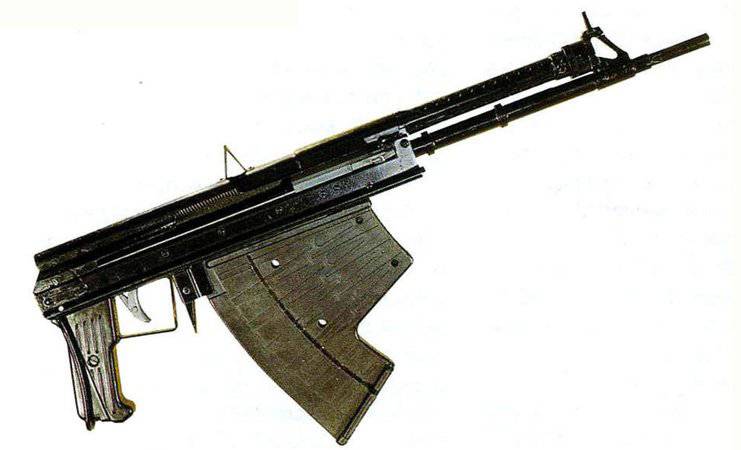
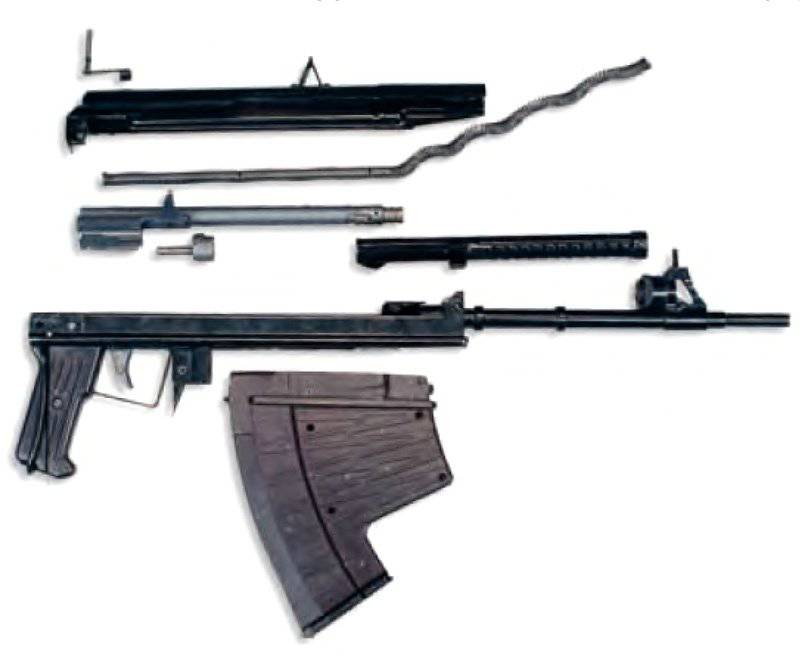
What gave all these bullets, nails, gas controllers, etc.? Under water, at a depth of about 5 meters, the effective range of fire is 30 meters. Deeper, on 20 meters, you can only shoot at 20. In both cases, the energy of the “nail” is enough to break through the wetsuit with foam lining or glasses made of Plexiglas (up to 5-7 mm) and the subsequent defeat of the enemy’s body. What is interesting, usually under water, visibility does not exceed the firing range of the MTA. In the air, the destructive power of a bullet remains at a distance of up to one hundred meters. However, a bullet unsuitable for air at such distances gives an indecent deviation. So the real range of the battlefield for airborne combat missiles in the air is not much different from that in the water, which is not enough for most skirmishes. Another argument against using an APS not in water is a resource. A submachine gun that can shoot 2000 underwater once in the air can only do 180 shots in the air - a tribute to optimization for working underwater.
Almost immediately, the APS was put into service. Production was established at the Tula Arms Plant, and it is conducted in small batches. At the moment, officially the machine is in service only in Russia. Foreign countries have the opportunity to order APS through Rosoboronexport, but so far they have only expressed their ability to purchase.
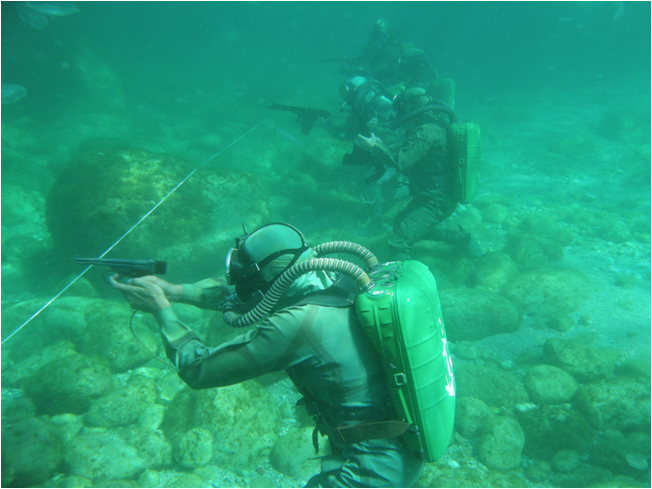
Despite its uniqueness, the MTA has its drawbacks. In particular, the lack of tactical: armed swimmers, if they have to lead and "land" battle, are forced to carry extra weight in the form of another machine gun. In appearance, the decision was obvious - to make an amphibious assault rifle, but in reality everything was more complicated. The creation of such a two-medium system took a lot of time, and its first copy was presented only at the end of the 90-s. Experiments on the “crossing” of APS and AK-74 were conducted at the Tula Design Technological Institute of Mechanical Engineering (TPKTIMash) under the supervision of designer Yu. Danilov. From the underwater predecessor, the new automaton, called the Sea Lion ASM-DT, received most of the structural elements, and from the Kalashnikov assault rifle cartridge 5,45х39 mm and a magazine. The shutter, the vapor system and the trigger moved from the APS to the AFM-DT without any changes, but the cartridge was modified. The same bullet, on the basis of which the MPS was made, was placed a new bullet, also similar to a nail, also with a blunt end, but of smaller caliber. With 5,6 millimeters, it has been reduced to 5,45. And that's why. Since the machine was originally developed as a two-medium, the designers took into account its ability to fight in the air. The cartridge 5,45x39 mm for normal performance required a rifled barrel, so it was decided to “squeeze” the bullet-nail to such dimensions, at which it could simply not cut into the rifling grooves.
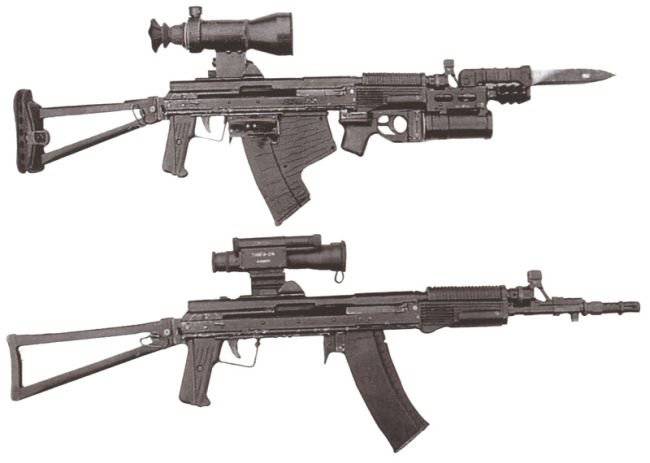
The underwater feeding of the ASM-DT is carried out from the stores of the APS submachine gun (26 ammunition). On the air, respectively, used shops from Kalashnikov assault rifles of the 74 series (30 cartridges). Since these stores, like cartridges, have different dimensions, the receiver of the stores received a very interesting design. If you need to dock the “underwater” magazine, a special spring-loaded lid (mounted at the bottom of the receiver on the left side) is retracted to the side, the magazine is inserted into the seat and secured with a latch. If the fighter is about to shoot 5,45х36 mm cartridges, the magazine latch moves all the way forward, and the spring-loaded lid closes the “extra” part of the magazine's receiver window. In addition to protecting the mechanics of the machine from dirt, the cover does not allow the magazine latch to move backwards. Another nuance of the two-media is as follows: when fired in the air, a part of the powder gases is redirected to the barrel in front of the bullet to blow it away from possibly remaining water there.
Sights "Sea Lion" in general, are similar to the MTA, but there is the possibility of installing an optical, night or collimator sight. Also, the designers have provided seats for a rifle grenade launcher, a tactical flashlight or LCC and a bayonet.
Nevertheless, the “native” amphibian AFM-DT did not go into the series. The main claims concerned the need to operate with two types of cartridges and shops. On the basis of the "Sea Lion" at TPKTIMash began the development of a new automatic machine, ADS. Its main difference from the ACM-DT was the layout of the bullpup.
In 2005, the Tula Instrument Design Bureau presented a new universal cartridge under the designation PSP. He, like the previous submarine ammunition, was made on the basis of the sleeve of the "land" cartridge 5,45x39 mm. Employees of KBP could enter in it a new steel bullet in weight of 16 grams. Bullet length - 53 mm. In this case, the designers managed to maintain the combat characteristics of the bullet due to the large elongation and flat nose of the bullet. Like the “nail” of the Union of Right Forces and the Ministry of Railways, the new bullet in the water creates a cavitation cavity around itself. At the same time, in the air, the bullet from the memory bandwidth behaves in the same way as the standard one. In addition, the PSP has the same dimensions as the standard cartridge 5,45x39 mm, which allows it to be used not only in the new underwater machine. A PSP-U cartridge was also created with a bronze bullet weighing 8 grams, intended for training purposes.
After the appearance of the PSP, the team of Yu. Danilov decided to finally abandon two different ammunition for different environments and make the machine anew under a single cartridge. At the same time, a new prototype, A-91, developed by Tula KBP at the beginning of 90-s, was chosen for the new version of ADS. The amphibian has received from A-91 the general layout of the bullpup circuit and a large number of plastic parts. Also, the designers left the tube, diverting spent cartridges, which allows you to use the machine and right-handers and left-handers. The shutter and the trigger also did not undergo major changes, in addition to modifications for operation in water. But the vapor system was reworked: a “water-air” mode switch appeared on the receiver. Like the AFM-DT, the ADF in the “air” mode drops excess powder gases for surface shooting and blows the barrel in front of the bullet.
Due to the dimensions of the PSP cartridge on the automatic transducer machine, shops from AK-74 to 30 cartridges are used. Including thanks to this, ADF can use not only PSP, but also cartridges 7H6, 7H10, etc., with the difference that the latter can not be used under water. The underwater characteristics of the ADF with PSP cartridges remained at the level of the MPS — the range of 28-30 meters at a depth of 5 m and 18-20 m at a depth of 20 meters. "Land" numbers, in turn, have grown and are slightly inferior to the characteristics of Kalashnikov 74-series machines. For example, the ADS sighting range in the air is not 30 meters, as in the MTA, but all 600.
Due to the layout of the bullpup, on the A-91 machine and, as a result, there is a carrying handle on the ADS. On it the open pillar is established. Fly located on the trunk. It is possible to mount an optical, collimator or any other compatible sight on the handle itself. Another detail inherited by ADF from the A-91 is an integrated grenade launcher caliber 40 mm. The grenade launcher can use all modifications of the VOG-25 grenades. The trigger of the grenade launcher is located under one bracket with the trigger of the machine gun (see photo). If the fighter does not need a grenade launcher, you can dismantle his barrel with an aiming gun on it. When the grenade launcher is removed, you can install a silent firing device or a nozzle firing attachment on the barrel of the machine gun.
Thus, TPKTIMasha engineers created a whole complex that in the future can replace several types of special forces weapons at once: APS and AK-74M assault rifles, as well as GP-25 and GP-30 grenade launchers. At the same time, a single ADS complex, with characteristics similar to other types, has advantages in terms of weight and size: it is more convenient and simple to transport and use one automatic machine with several body kit parts than several different weapons at once. And it seems that the Tula people really managed to please the special forces: in 2009, the ADF entered the tests in special forces fleet, and it is known that the complex has earned many positive reviews.
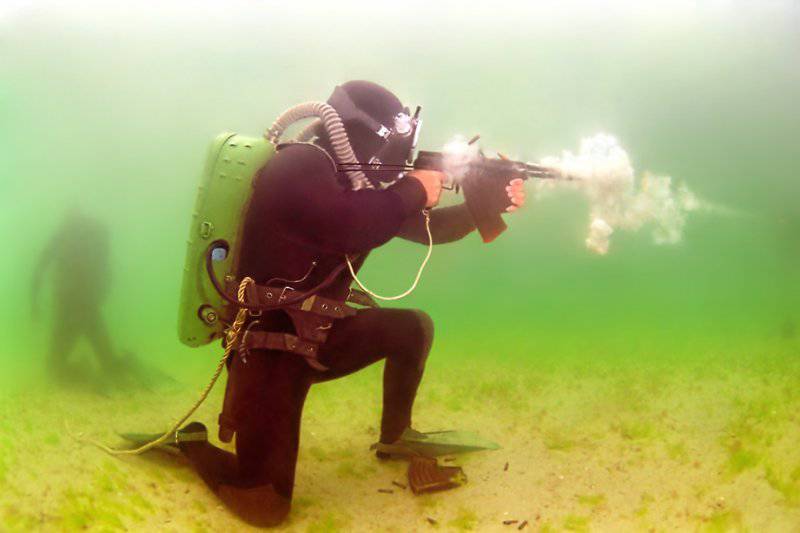
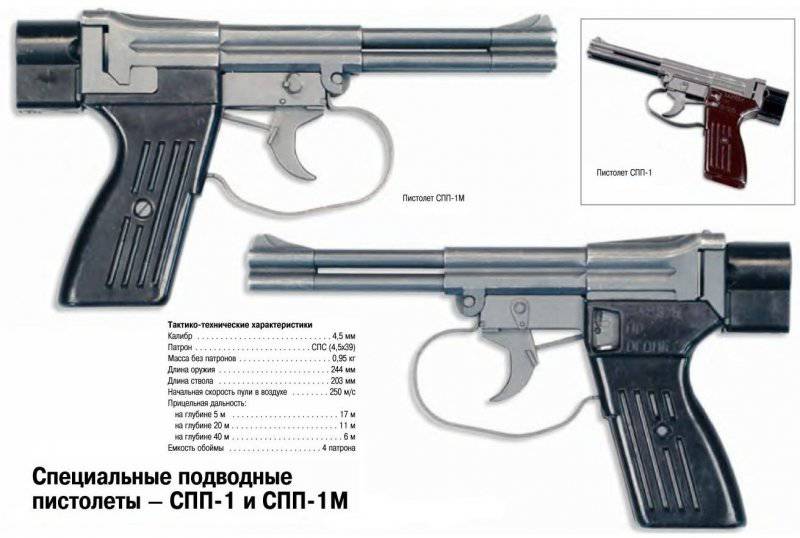
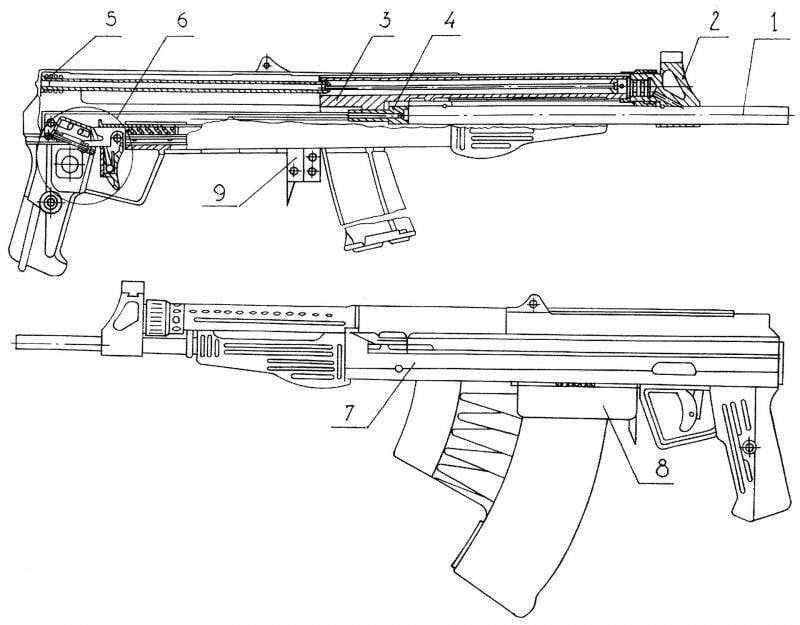
Information